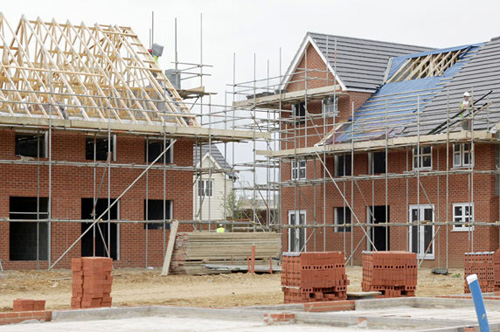

Right: Gavin Barwell, Minister for Housing 2016 -2017 and responsible for the housing White Paper which paved the way for current government policy on planning. It introduced the ‘affordability adjustment’ to the calculation of housing need. He pointed the finger at councils for being ‘free to come up with their own methodology for calculating objectively assessed housing need.’ He lost his seat in the 2017 general election, but was given a life peerage in 2019.
The Westminster government has a standard method for working out ‘local housing need’, called the Strategic Housing Market Assessment (SHMA) formula. This method of calculation produces a local housing need figure for the borough of 804 dwellings per annum from 1 April 2019, getting on for double what the figure would be if based only on the government’s annual increase in local households projection, roughly 440.
Wokingham Borough Council’s recently released Local Plan Update takes issue with the government’s SHMA formula. It points out ‘failings’ with this method, as applied to Wokingham Borough. It disputes ‘the premise of the standard method that higher house building will stabilise or lower house prices’, pointing to the ‘upwards impact of substantial house building on the median house price’ (p. 77). So who’s right? What can we tell from publicly available information about how house prices across the borough have been affected, since construction of the Strategic Development Locations began about five years ago?
No impact
We can start by looking at Zoopla’s property value increases 2015-2020 for localities in Wokingham. These show that those with the most new housing have not seen house prices moderate. If anything, prices have increased there rather more than elsewhere, though overall there’s very little difference across the borough:-
Arborfield 22.67%
Lower Earley 22.67%
Shinfield/Spencer’s Wood/Three Mile Cross 22.67%
Twyford 22.67%
Woodley 22.67%
Hurst 22.66%
Sonning 22.66%
Barkham 21.73%
Finchampstead 21.73%
Winnersh 21.73%
Crowthorne 21.72%
Source: https://www.zoopla.co.uk/house-prices/browse/ Accessed 17/2/20
These figures use valuations, not actual sale prices, but the SHMA formula is not based on actual sale prices either.
It could be argued, of course, that this 5-year comparison fails to reflect the true impact of new housing coming on to the market, which has taken major effect only in the last couple of years. Zoopla does not allow a price comparison over two years. However, Rightmove does: it tracks house sale prices over the most recent two-year period. NB: It uses general postcode areas, rather than being searchable by locality like Zoopla.
No correlation
The Rightmove site’s 2-year changes in average house sale prices per postcode area Nov. 2017-Oct. 2019 show the following picture, as percentages:-
Postcode area Includes: % change Nov. 2017-Oct. 2019
RG 40 (Wokingham, Finchampstead) 36.8
RG 2 (Sth Rdg, Shinfield, Arborfield Garrison) 22.8
RG 5 (Woodley) 14.2
RG 10 (Hurst, Crazies Hill) 2.5
RG 41 (Winnersh, Barkham, Emmbrook) -0.2
RG 45 (Crowthorne) -9.6
RG 7 (Three Mile X, Spencer’s Wood, Swallowfield) -11.1
RG 6 (Lower Earley) -12.8
Source: https://www.rightmove.co.uk/house-prices-in-my-area.html Accessed 17/2/20
These figures certainly don’t support the government’s idea that having more housing in an area will moderate house prices. Woodley (RG 5) has seen substantial new housing on the old airfield site, but RG5 prices have climbed by 14%. The RG2 postcode area is the one where most new housing since 2010 has been built, in Shinfield and Arborfield Garrison. Yet over the last two years it has shown one of the biggest increases in average house sale prices, nearly 23%! Conversely, Lower Earley (RG 6), where not much new housing was built this century, shows the largest sale price drop. The northern villages from Hurst to Crazies Hill in RG 10 have seen little extra housing, but also only a very small sale price increase.
So we see no correlation between having more housing in an area, and slackening house prices in that area. Figures from this borough suggest that the government’s ‘affordability adjustment’ to calculating ‘housing need’ is based on a flawed assumption, and the Council are right to question it.
False assumptions
The government’s ‘affordability adjustment’ looks like traditional market economy thinking: increase supply and prices will fall. But it’s no secret that this crude notion doesn’t work for today’s property market. It’s been known for quite a while. As a 2016 study pointed out: ‘New houses constitute only a very small part of the housing stock, so new housing has negligible effects on the overall market until the numbers reach into the millions….Demand is almost unbounded (both from UK and from international investors), so supply can never “meet” demand.’
Similarly, a 2015 joint study by the London School of Economics and Barratt Homes concluded that ‘new housing developments appear to have little discernible impact on local house price patterns’.
Last year, the Westminster SHMA formula was slated in a study that undermined another of its assumptions: ‘Household projections have for many years significantly overestimated the rate of household formation due to questionable assumptions in the official methodology. The Office for National Statistics (ONS) has recently taken action to address these…. Had the ONS’s new methodology applied for the past decade, we would be… hearing housing need figures of around 160,000 per year, rather than the 250,000 number in the government’s 2017 housing white paper.’
In short, house prices aren’t really affected by new housing, even in the numbers being built around here, and there won’t be as many new households requiring homes as Westminster claims. The ‘affordability’ strategy won’t work, and the ‘local need’ figures aren’t reliable.
Central government and its civil servants seem strangely unaware of findings such as these. The flawed assumptions in their housing formula surely need to be reconsidered urgently. In the meanwhile, making local authorities continue to use the formula looks wrong, and it’s good to see that WBC is challenging it.
Sources
https://www.gov.uk/guidance/housing-and-economic-development-needs-assessments
https://housingevidence.ac.uk/wp-content/uploads/2019/08/20190820-CaCHE-Housing-Supply-FINAL.pdf
Article by Richard R